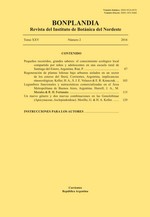Ver ítem
- xmlui.general.dspace_homeCentros e Institutos de InvestigaciónCIRN. Centro de Investigaciones de Recursos NaturalesInstituto de Recursos BiológicosArtículos científicosxmlui.ArtifactBrowser.ItemViewer.trail
- Inicio
- Centros e Institutos de Investigación
- CIRN. Centro de Investigaciones de Recursos Naturales
- Instituto de Recursos Biológicos
- Artículos científicos
- Ver ítem
Legumbres funcionales y nutracéuticas comercializadas en el Área Metropolitana de Buenos Aires, Argentina
Resumen
En este trabajo se analizan datos de relevamientos etnobotánicos de especies de legumbres (Leguminosae) funcionales y nutracéuticas comercializadas en el área Metropolitana de Buenos Aires, Argentina. El estudio fue realizado en comercios del circuito general y de los circuitos restringidos de inmigrantes bolivianos y chinos. Se registraron las especies, productos, usos terapéuticos locales y datos disponibles sobre actividad biológica y efectos
[ver mas...]
En este trabajo se analizan datos de relevamientos etnobotánicos de especies de legumbres (Leguminosae) funcionales y nutracéuticas comercializadas en el área Metropolitana de Buenos Aires, Argentina. El estudio fue realizado en comercios del circuito general y de los circuitos restringidos de inmigrantes bolivianos y chinos. Se registraron las especies, productos, usos terapéuticos locales y datos disponibles sobre actividad biológica y efectos estudiados. Se registraron 19 especies de legumbres: Arachis hypogaea var. hypogaea, Cicer arietinum, Glycine max, Lablab purpureus, Lens culinaris, Lupinus albus, L. mutabilis, Medicago sativa, Phaseolus lunatus, P. vulgaris, Pisum sativum, Prosopis alba, Tamarindus indica, Trifolium repens, Trigonella foenum-graecum, Vicia faba, Vigna angularis, V. radiata y V. uniguiculata var. unguiculata. La mayoría de las especies (15) se hallaron en el circuito comercial general y unas pocas (4) en los circuitos restringidos de los inmigrantes, entre estas L. mutabilis, que merece mayor difusión. En la mayoría de los casos, los usos locales asignados a las especies relevadas tienen correlato con los datos disponibles en la literatura sobre su actividad biológica y efectos evaluados. La información brindada en esta contribución aporta tanto a los estudios etnobotánicos como a la difusión de la relevancia terapéutica de las legumbres en el área de estudio.
[Cerrar]
In this work, we analyzed data from ethnobotanical surveys of functional and nutraceutical legumes (Leguminosae) commercialized in the metropolitan area of Buenos Aires, Argentina. The surveys took place in outlets of the general commercial circuit and the restricted circuits belonging to Bolivian and Chinese immigrants. We recorded the species, its products, local therapeutic uses, and available published data on biological activity and effects. Nineteen
[ver mas...]
In this work, we analyzed data from ethnobotanical surveys of functional and nutraceutical legumes (Leguminosae) commercialized in the metropolitan area of Buenos Aires, Argentina. The surveys took place in outlets of the general commercial circuit and the restricted circuits belonging to Bolivian and Chinese immigrants. We recorded the species, its products, local therapeutic uses, and available published data on biological activity and effects. Nineteen species were found: Arachis hypogaea var. hypogaea, Cicer arietinum, Glycine max, Lablab
purpureus, Lens culinaris, Lupinus albus, L. mutabilis, Medicago sativa, Phaseolus lunatus, P. vulgaris, Pisum sativum, Prosopis alba, Tamarindus indica, Trifolium repens, Trigonella foenum-graecum, Vicia faba, Vigna angularis, V. radiata and V. unguiculata var. unguiculata. Most of these species (15) were found in the general commercial circuit, whereas the rest (4) only in the restricted commercial circuits of immigrants, including L. mutabilis, which deserves a
wider diffusion. In most cases, the local uses assigned to a surveyed species correspond to the
information available in the literature on the species’ biological activity and effects. This paper provides new insights for ethnobotanical studies and highlights the therapeutic relevance of legumes in the study area.
[Cerrar]

Autor
Hurrell, Julio Alberto;
Morales, Matias;
Fortunato, Renee Hersilia;
Fuente
Bonplandia 25 (2) : 115-128. (2015)
Fecha
2016
Editorial
Instituto de Botánica del Nordeste
ISSN
0524-0476
1853-8460
1853-8460
Formato
pdf
Tipo de documento
artículo
Palabras Claves
Derechos de acceso
Abierto
 Excepto donde se diga explicitamente, este item se publica bajo la siguiente descripción: Creative Commons Attribution-NonCommercial-ShareAlike 2.5 Unported (CC BY-NC-SA 2.5)
Excepto donde se diga explicitamente, este item se publica bajo la siguiente descripción: Creative Commons Attribution-NonCommercial-ShareAlike 2.5 Unported (CC BY-NC-SA 2.5)


